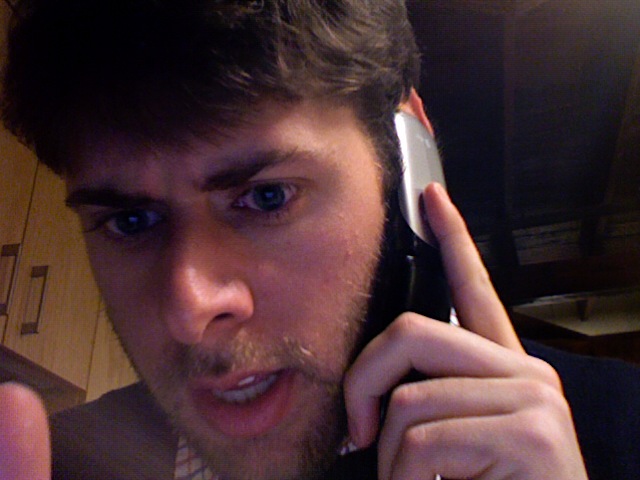
There’s this amazing moment in one of Carl Reiner’s and Mel Brooks’ “2000 Year Old Man” sketches, when Reiner is moving through a line of questions about the early days of man. He’ll get to the good stuff in a second — questions about Joan of Arc, questions about the secrets to longevity — but first, he’s got a softball. “What was the main means of transportation back then?” he asks.
Brooks’ response is classic deadpan, and he crushes it. “Fear,” he says. “You’d see a tiger, and you’d run a mile in a minute.”
We don’t have such sources of transportation inspiration anymore. Except for one, really: the fear of missing an airplane.
On Thursday, I was nearly confined to the multi-thousand square foot beast that is Houston’s George Bush Intercontinental Airport.
So I ran.
❡❡❡
The last time I made the airport sprint was in San Francisco. My shuttle to the airport was late — by an hour. My flight was on time. From curb to last-call at my gate, I’d been given 14 minutes. But San Francisco International is a relatively easy airport. Each wing has its own security checkpoint, servicing just a dozen or so gates, and I didn’t have any bags to check in, so I butted in line, apologized profusely and then ran — my left hand keeping my pants up, my heavily duct-taped roller bag and belt over my head and waving behind me. I ran like Reggie Bush on a punt return, dodging travelers, spinning away from golf carts, my eyes upterminal at all times. I made it to the gate — the very last gate in the terminal, of course — in time.
I gasped.
I heaved.
But I was on the plane.
❡❡❡
My sense is that Americans, in general, love to procrastinate. We also love to be lazy, to lounge around and to waste time.
So it should follow, logically, that getting a few hours to kill at the airport would be an American pastime.
That’s how I used to feel, actually. When I was young, I’d to ride the subway down with my dad to National Airport in D.C., and we’d sit by the windows and watch the planes take off. Some fathers and sons went to baseball games or the zoo to relax; we went to the airport.
But most Americans don’t see the airport as a relaxing place. That’s why we have a phrase for the occasion: stuck at the airport. Or worse: stranded at the airport.
In all your years, have you ever heard anyone outside of a first class lounge talk excitedly about an extended airport layover? Don’t worry about me, honey. I’ve got four whole hours to spend at Boston Logan!
As a society, we are not claustrophobic, but we fear airport-based confinement, and all of its trappings: patience, non-reclining chairs and doubly-overpriced Starbucks.
Maybe it’s just the way we define airports. We break them up into sections — Terminals, we call them — but we view them with a lower case ‘T.’ As in: beyond curable. Beyond suffering.
As in: the stage just before the light.
❡❡❡
The first sign of trouble hit my inbox on Thursday. There they were two e-mails from Continental Airlines informing me that my flight to Houston had been delayed. I looked at the details. Both said my 8:35 flight had been delayed to…. 8:35. Whatever.
By the time I’d gotten to San Antonio, the departure monitors told a different story. The 7 a.m. to Houston still hadn’t taken off yet. The 8:35 was delayed until 10:15.
My connecting flight in Houston left at 10:30.
I’ll fast-forward for you: I got on a non-delayed 9:15 flight, due to land in Houston’s Terminal C at 10:10. The connection was over in the B gates, no. 75. High numbers are never a good sign, and when my San Antonio flight stalled on the runway for 10 minutes — broken radars in the control tower, the captain said — I wasn’t optimistic about getting to B75 in time.
But we touched down at 10:04, and I was sitting in row 8, and the flight attendant said that since so many people had been delayed that morning, please, for the courtesy of your fellow passengers, let’s have only the passengers with urgent connecting flights stand up when the plane stops.
The plane stopped. The first eight rows stood up.
One guy was connecting to Kansas City. Another to New York. Someone else to Albuquerque, I think.
The doors opened, and we ran.
We ran through the jetway, where the emergency alarm had sounded when the gate agent had goofed in a rush to open the doors for us. We ran through the noise and into….
…Terminal E. Not, as I’d been told, Terminal C, only a quick one-hop subway connection away from my B gate. Instead, I was in the third-to-last gate in the terminal farthest away from where I needed to go. I’d have to cover over a mile of airport in about 12 minutes.
Naturally.
But my next gate hadn’t changed: B75. At least I knew my destination.

❡❡❡
There are three keys, in my opinion, to surviving the airport sprint:
1. Use the Reverse Jinx: Sitting in San Antonio International on Thursday, I knew two things:
A. If I didn’t eat, I’d make my connecting flight but not have enough time to grab a bite in Houston, and I might not eat anything until 2 or 3. That wouldn’t do.
B. If I did eat, I’d miss my connecting flight and have three hours of waiting in Houston, with plenty of time to eat. And I wouldn’t be hungry, because I’d already eaten. That wouldn’t do, either.
So I grabbed a sandwich and secretly hoped to reverse jinx my way into the perfect scenario: eat early and make my connection. (Spoiler alert! It paid off — except for the part where I had to sprint through an airport terminal with a belly full of McMuffin. But more on that later.)
2. Be Loud: When you’re running, make sure people hear you coming. Be loud, and people will clear a path for you as you run. An airport sprinter is a wrecking ball-in-waiting, so make your presence known. Yell, holler, wear clogs — whatever it takes. There’s a reason those airport golf carts have sirens on them.
3. Look Desperate, But Don’t Panic: If you only take one piece of advice here, take this one. When you’re clomping down a terminal, you want people to look up and instantly know which person is rushing to a flight. Your face needs say, Please, for all that is holy, don’t make me stay one second longer than I need to in this place. But internally, you’ve got to stay poised. I’ve seen roller bags go flying out of control in airports. Stay in control, and let your legs do the rest.
❡❡❡
I ran right, then left, then across a moving walkway. My roller bag skidded behind me; the duct tape on the handle seemed to be holding things together nicely. I wheeled past the international terminal, passengers from Guam and Guatamala looking both groggy and very much not on high alert for me, this 6’6” thing cannonballing into Terminal D, where I could catch the inter-terminal train. Up the escalator, passing a couple on the right — sorry! — I made it to the train.
If the Google Maps tool over at WalkJogRun.net is to be believed, I’d just sprinted just over a quarter mile. In sandals. While wheeling a bag and hauling another one over my shoulder. Through an international terminal.
We reached Terminal C at 10:19. I had a chance, but the train pulled away slooo….. ooowwww…. wwlyyyy. We inched along. Terminal B arrived at about 10:22. My gate was just closing, if I was lucky. Maybe the airport door hadn’t shut, too. I had two minutes, tops.
Out on the platform, there were two escalators, both headed down. The guy going to Kansas City was a step behind me, and I beat him to it. I was in full-on “American Gladiators” mode, demolished the escalator and spun onto the main concourse. Lesser airport gladiators would crumble at the sight of the Houston Intercontinental eliminator; I hung in.
I should say here the floors in Terminal B are different, older. They’re a thin layer of carpet over concrete, and I was running in sandals. The thwap of each step echoed behind me, like “Riverdance” in snowshoes.
Terminal B opened into a square-shaped area, with four corridors leading out from each corner. Gates 76 and above were up on the side next to the train.
Gates 75 and below were not.
So there was another run, this time through the square, past another food court and to the right. It was the home stretch, the last tenth of a mile sprint through the B concourse, and my legs sagged. I wanted to quit. I wanted to stop sprinting. I was defeated.
And then, the tunnel turned. There was light.
❡❡❡
“Breathe, honey, breathe.”
I continued to pant, gasp, sweat. The gate agent, Rosetta, printed out my boarding pass. “Oshinsky? Coming from San Antonio? No way I thought you’d make it. Where’d you come from?”
E22.
“That’s amazing.”
The airplane door hadn’t closed yet, so she walked me down the gateway. I was still sucking for air. She mentioned something about wishing that she had my speed, and I laughed. No one had ever called me fast before.
I tried to tell her that, but it came out something like, “Eyyyee [gasp] mmmm not [gasp gasp] thaaat fass [gasp] ttt.”
I was boarding a puddle jumper, so my roller bag had to be checked plane-side. My breath was coming back, and I asked Rosetta if airport employees had a word for what I’ve just done.
“You know, we used to call it — well, before the trial — we used to call that the O.J. sprint.”
I looked back at her before I board the plane. I got here, I wanted to tell her. But I won’t go there.








 In the summer of 2009, having just accepted a job at a TV station in San Antonio, Texas, I attempted to convince my bosses to allow me to channel
In the summer of 2009, having just accepted a job at a TV station in San Antonio, Texas, I attempted to convince my bosses to allow me to channel 


